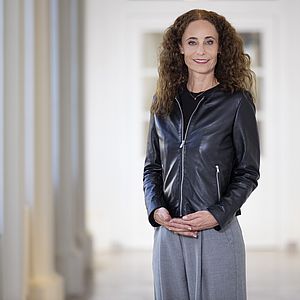Decoration and elimination
The triple function of the Landhaus in a single ensemble – party headquarters, Gau administration and Reich Governor’s office – was clearly reflected in the diversity of the interiors. While the conference room is modelled on the “Reich Chancellery style”, Gauleiter Hofer’s office was a much more personal solution in the form of a “Tiroler Stube” (Tyrolean parlour) with no precedent in the Nazi design canon. With regard to the artworks selected for the various rooms, too, the party leaders adhered to the principles applied in the “Altreich” but with a clear focus on Tyrolean motifs. A national hero was made out of the 17th century Chancellor Biener through the decision to hang Karl Anrather’s history painting of Biener at the 1640 Tyrolean Diet in the conference room.
The various Nazi insignia, the banners with the swastika, the Reich eagle on the east facade, and the obvious Nazi symbols and propaganda images in the interiors, were mostly removed on the orders of the Allied occupying forces immediately after the surrender of the German army. Some Nazi symbols, however, disappeared only gradually in the course of time.
History painting by Karl Anrather. Chancellor Biener as a national hero
1. Hermann Schmid, “The Chancellor of Tyrol”, 1863 (Berlin 1929)
2. The painting of “Claudia de Medici and Chancellor Biener at the Tyrolean Diet” in Hitler’s apartment in the Hotel Tyrol, 1938, photo: Wilhelm Stigler, Archiv für Bau.Kunst.Geschichte
1. With the growth of nationalism in the 19th century, the narrative of the 1640 Tyrolean Diet and the part played by Chancellor Biener became even more attractive. Hermann Schmid wrote a historical novel about the “Chancellor of Tyrol”, which was published in 1863 and reprinted several times until 1935.
2. During Adolf Hitler’s visit to Innsbruck in April 1938, the painting was used to decorate his apartment in the Hotel Tyrol. The hotel furnishings were commissioned from the architect Wilhelm Stigler. He took the opportunity to present his latest furniture designs and produced a series of photographs of his interiors.
“Claudia de Medici and Chancellor Biener at the Tyrolean Diet” by Karl Anrather
The history painting of “Claudia de Medici and Chancellor Biener at the Tyrolean Diet” was painted by Karl Anrather in 1890. It was purchased by the Tyrolean State Museum on account of its great public success. The painting focuses on Archduchess Claudia de Medici and Chancellor Wilhelm Biener at the Diet held in Innsbruck in 1640. It depicts the escalation of a longstanding conflict between the Tyrolean nobility and peasants, and the Catholic prince-bishops of Brixen and Trent, who were demanding territorial autonomy from the Tyrolean sovereign and the right to levy their own taxes. They threatened to sever their ties with Tyrol. With the help of the soldiers he summoned, Chancellor Biener prevented the rebels from leaving the Diet. Under Claudia de Medici’s successor, Biener’s political opponents managed to have him arrested and executed in 1650. In the 19th century in particular, Chancellor Biener was celebrated for his commitment to all-German national consciousness. For the Nazi regime, Biener served as the personification of the end-of-the-war mantra of fighting to the last man.
Reich Chancellery style
1. Design of the conference room by the architects Walter and Ewald Guth, Archiv für Bau.Kunst.Geschichte
1. The architects Walter and Ewald Guth designed a panelled conference room for the Landhaus in the Berlin “Reich Chancellery style”, which was standard for Nazi buildings. In view of the tight construction schedule, with the party offices due to be ready for use by the summer of 1939, the conference room was initially only plastered and painted. One year later, the room was given a new look with oak veneer panelling. The size of the panels was determined by the dimensions of the painting of “Claudia de Medici and Chancellor Biener at the Tyrolean Diet”, with the panelling omitted on the wall behind the painting. Since the painting had previously been hung in Hitler’s hotel rooms in Innsbruck, it was considered suitable for the conference room in the party headquarters.
Elimination of Nazi insignia
1. Signing of the surrender document in the conference room of the Landhaus, 5 May 1945, with a white surface visible above the wood panelling in the background, National Archives Washington
2. Removal of Nazi symbols from the wooden ceiling, Pescoller Werkstätten
3. East facade of the Landhaus with the coats of arms of Tyrol and Vorarlberg and the Nazi party eagle, drawing by Albert Bermoser August 1939, TLA
4. Balustrade with swastikas, StAI
1. General Erich Brandenberger, commander-in-chief of the 19th Army, signed the articles of surrender in the conference room on 5 May 1945. The American forces of occupation established their base in the Landhaus extension. The painting of “Claudia de Medici and Chancellor Biener at the Tyrolean Diet” was taken down in the course of the removal of all Nazi images and symbols. The painting was not rehung in its present position until 1956, after the Tyrolean regional government had moved into the Landhaus.
2. On the ceiling of the conference room, the suspension points for the large chandeliers are decorated with inlays in the shape of cogwheels. Together with the swastika, the cogwheel was the emblem of the largest Nazi organisation, the German Labour Front (DAF). During restoration work carried out in January 2023, pieces were found to have been cut out of the frames of the panelled ceiling and the voids concealed with veneered wood. It can be assumed that the voids resulted from the removal of swastikas.
3./4. On the east façade of the Landhaus are the coats of arms of Tyrol and Vorarlberg. They bear witness to the merger of the two provinces into a single Gau under the Nazis. The empty space between the two coats of arms was occupied by a Nazi party eagle until mid-July 1945.
In the course of the construction of the Liberation Monument in 1947/48, the swastikas on the iron balcony and window balustrades were removed.








